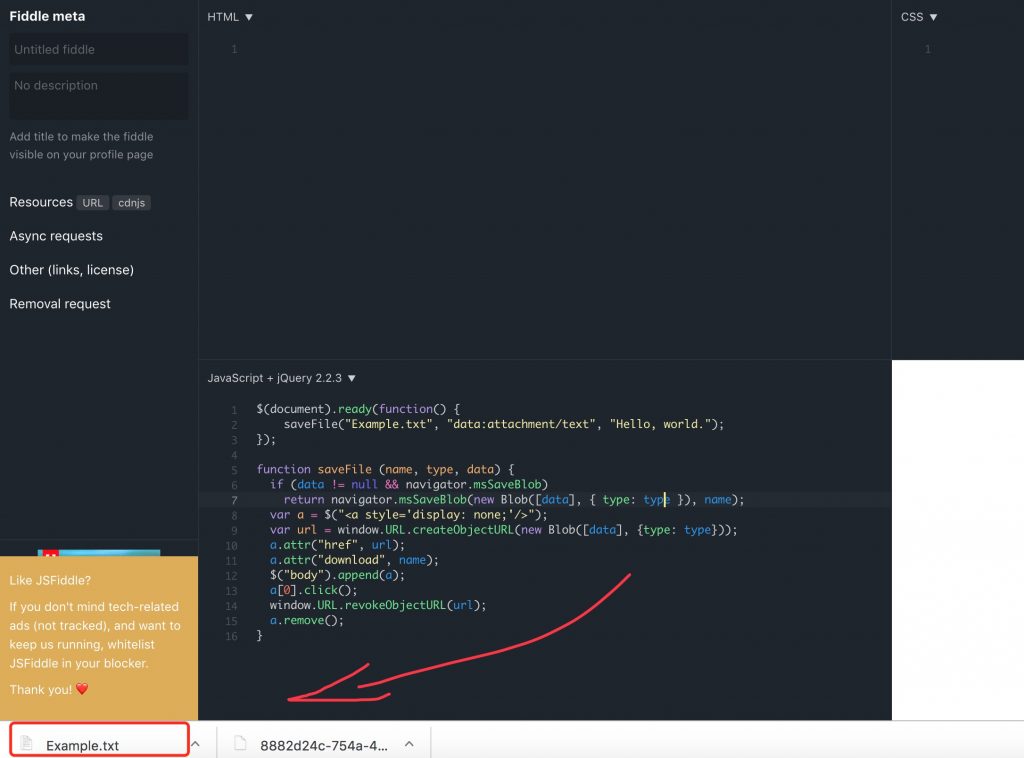新闻资讯
强制下载时,如何在JavaScript中设置Blob文件名称?

当强制通过window.location下载时,如何在JavaScript中设置blob文件的名称?
function newFile(data) { var json = JSON.stringify(data); var blob = new Blob([json], {type: "octet/stream"}); var url = window.URL.createObjectURL(blob); window.location.assign(url);
}
运行上面的代码会立即下载文件而不会刷新页面,文件名类似如下所示的随机字符串:
bfefe410-8d9c-4883-86c5-d76c50a24a1d
那么我想将文件名设置为my-download.json,该怎么做?
最佳解决思路
我知道的唯一方法是FileSaver.js使用的技巧:
- 创建隐藏的<a>标记。
- 将其href属性设置为blob的URL。
- 将其download属性设置为文件名。
- 单击<a>标记。
这是一个简化的例子(jsfiddle):
var saveData = (function () { var a = document.createElement("a"); document.body.appendChild(a);
a.style = "display: none"; return function (data, fileName) { var json = JSON.stringify(data),
blob = new Blob([json], {type: "octet/stream"}),
url = window.URL.createObjectURL(blob);
a.href = url;
a.download = fileName;
a.click(); window.URL.revokeObjectURL(url);
};
}()); var data = { x: 42, s: "hello, world", d: new Date() },
fileName = "my-download.json";
saveData(data, fileName);
我写这个例子只是为了说明这个想法,在生产代码中使用FileSaver.js代替。
注意
- 较旧的浏览器不支持”download”属性,因为它是HTML5的一部分。
- 浏览器认为某些文件格式不安全,会下载失败。保存带有txt扩展名的JSON文件对我有用。
次佳解决思路
我扩展了上文中的答案,可支持Internet Explorer(大多数现代版本),并且使用了jQuery整理代码:
$(document).ready(function() {
saveFile("Example.txt", "data:attachment/text", "Hello, world.");
}); function saveFile (name, type, data) { if (data != null && navigator.msSaveBlob) return navigator.msSaveBlob(new Blob([data], { type: type }), name); var a = $("<a style='display: none;'/>"); var url = window.URL.createObjectURL(new Blob([data], {type: type}));
a.attr("href", url);
a.attr("download", name);
$("body").append(a);
a[0].click(); window.URL.revokeObjectURL(url);
a.remove();
}
第三种解决思路
与上述解决方案相同的原理。但我遇到了Firefox 52.0(32位)的问题,其中大文件(> 40 MBytes)在随机位置被截断。 Re-scheduling调用 revokeObjectUrl()解决了这个问题。
function saveFile(blob, filename) { if (window.navigator.msSaveOrOpenBlob) { window.navigator.msSaveOrOpenBlob(blob, filename);
} else { const a = document.createElement('a'); document.body.appendChild(a); const url = window.URL.createObjectURL(blob);
a.href = url;
a.download = filename;
a.click();
setTimeout(() => { window.URL.revokeObjectURL(url); document.body.removeChild(a);
}, 0)
}
}
第四种思路
我遇到了同样的问题,我的解决方案。
function newFile(data, fileName) { var json = JSON.stringify(data); //IE11 support if (window.navigator && window.navigator.msSaveOrOpenBlob) { let blob = new Blob([json], {type: "application/json"}); window.navigator.msSaveOrOpenBlob(blob, fileName);
} else {// other browsers let file = new File([json], fileName, {type: "application/json"}); let exportUrl = URL.createObjectURL(file); window.location.assign(exportUrl);
URL.revokeObjectURL(exportUrl);
}
}
第五种思路
saveFileOnUserDevice = function(file){ // content: blob, name: string if(navigator.msSaveBlob){ // For ie and Edge return navigator.msSaveBlob(file.content, file.name);
} else{ let link = document.createElement('a');
link.href = window.URL.createObjectURL(file.content);
link.download = file.name; document.body.appendChild(link);
link.dispatchEvent(new MouseEvent('click', {bubbles: true, cancelable: true, view: window}));
link.remove(); window.URL.revokeObjectURL(link.href);
}
}
回复列表








